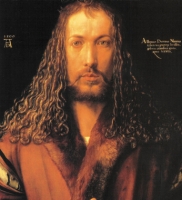07 Mar 2016 | 1 Comments
Try Sleeping on Dürer’s Pillows
Surprise, surprise. In great art you never stop seeing new perceptions in long-familar images because art by its very nature exists on multiple levels. And seeing them without help from others is both edifying and deeply satisfying, certain to b
18 May 2015
Still-lifes by Peale and Core [from the Archives]
Names are important in art. The American master Charles Willson Peale (1741-1827) had three sons who became painters: Rembrandt, Raphaelle [sic] and Titian. His fourth son was Rubens. Raphaelle is thought to be America’s first still-life painter
06 Oct 2014 | 1 Comments
Dürer, Titian, Art and Blasphemy
For those who have trouble - I certainly did - understanding how artists like Dürer (top) and Titian (below) could have portrayed themselves as Christ, here is a poem attributed to an 11th-century spiritual master of the Greek Orthodox Church
09 Sep 2013 | 2 Comments
Art’s Unknown Frown
Artists frown. Constantly. Why? Charles Darwin considered the corrugator, the muscle which results in a frown, as the most remarkable of the human face because it irresistably conveys the idea of mind.1 And that's why, in my opinion, artists hav
20 Apr 2013
Do you know what it means to come home?
Think differently. The old ways are often dull and didactic. Take, for instance, paintings and prints that seem to illustrate Bible stories. Why treat them as a narrative when mystical Christians, among whom must be counted many great Western ar
08 Mar 2013
Dürer’s Foreign Language
"The art of painting cannot be truly judged save by such that are themselves good painters: from others, verily is it hidden, even as a strange tongue."
Albrecht Dürer (1471-1528)1
If, as I believe, Dürer disguised
12 Jul 2012
Ink Flies in a Mind
If anyone doubts that St. Sebastian holds a special place in the creative mind as a symbol of the artist’s self and the idea that every painter paints himself, then take a look at Jaff Seijas’ self-portrait above. It is not proof but it is t
28 May 2012
Coins, tablets and Dürer
Coins draw groans. Walk into a roomful of coins in a museum and even the most ardent art lovers hurry through in the hope of finding some painting or sculpture on the other side. Nevertheless the designs on coins are one of the glories of Greek
24 May 2012
Durer: “For Christ’s sake, can’t you see that….
An article featured on the Home page of The Art Newspaper's website announces the opening of an important exhibition on Dürer. It reports, however, that Dürer’s Munich Self-portrait (above): “continues
18 May 2012
Joseph Leo Koerner and the Artist as Christ
Occasionally I see an image that turns on a light and helps illuminate an artist's way of seeing quite concisely. Fittingly, an illumination is one of them. The best book ever written on self-portraiture is probably Joseph Leo Koerner’s The Mo
23 Mar 2012
Poems are Animals
A recent exhibition posted an interesting quote by the poet Ted Hughes. It was somewhat out of their context but in ours because I, of course, argue that true art is like a visual poem. Remember as you read it that although many published poems
23 Feb 2012
Faces in Our Minds
Humanity’s existence is so dependent on recognizing faces that our visual system specializes in it, reserving a large proportion of the brain’s neurons solely for that purpose. Amazingly we can even recognize a person in profile when we have
17 Sep 2011
Artists are Animals
“Artists are animals” may seem like a derogatory statement but artists are animals and both art and intelligence are products of nature. We are not separate. We all play our part in the cosmos, all created by similar processes: rats,
30 Aug 2011
Do Poets understand Painting?
A couple of days ago I questioned whether the poets in an artist’s social circle have any greater understanding of their friend’s art than we do. I am always surprised by how art historians give so much credit to the opinions of poet
02 Aug 2011
Dürer’s Portrait of Philip Melanchthon (1526)
Durer’s 1526 Portrait of Philip Melanchthon is notable for the manner in which the artist treats the eyes. One eye is large, bright and clear; the other mostly unseen, the tip of its eyelash just visible above the clouds. This contras
20 Apr 2011
Celebrating Good Friday
Isn’t it rather morbid and paradoxical for Christians to celebrate the death of Christ on Good Friday? What’s so good about killing your God? Ah, you’ll be told, that was the day He died for our sins for all humanity? But doesn
25 Feb 2011
The Spell of Gossaert
The Jan Gossaert (c.1478-1532) exhibition that was on at the Met in New York last year has now moved in truncated form to London’s National Gallery. There are 37 of his 63 extant paintings in London. The Met had 50. Yet there i
09 Dec 2010
Exit the King
Anyone wondering why artists represent themselves as kings – why Fouquet painted himself in 1450 as Charles VII or Ingres as Napoleon or even Lucian Freud as Queen Elizabeth II - might like to read Eugène Ionesco&rsqu
23 Nov 2010
Art and Eckhart
“Knowledge of Meister Eckhart’s work is indispensable to the understanding of medieval art, even though he has been almost totally neglected by those who like to call themselves ‘historians of art.’”
So wro
19 Oct 2010
Wisdom in the Chilean Dark
Everyone has their own memorable moment in the story of the Chilean miners. Mine came after the first few of the buried men arrived on the surface. One declared in translation: “Underground, I was with God and the Devil. They fought each o
The EPPH Blog features issues and commentary.



















